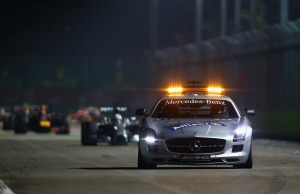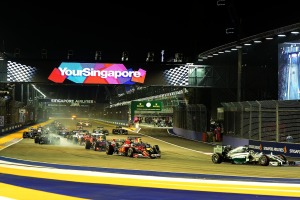This year’s Singapore Grand Prix was certainly a race in which it paid to be bold on strategy. There was the inevitable Safety Car, at half distance, maintaining the circuit’s 100% record of Safety Cars and there were some very different strategies at work, which decided the outcome of the top 10 finishing positions.
 It took Ferrari’s Fernando Alonso out of second place and put him down in fourth and it saw Jean Eric Vergne and Sergio Perez take a late gamble for new tyres and pass seven and nine cars respectively in the final 15 laps. The key to this race was the tyre choice for the third stint and how early in the race teams committed to that decision, as we shall see. Friday practice showed that the Pirelli tyres were degrading quickly and also that the gap in performance between the soft and supersoft was huge; as much as 2.5 seconds per lap on some cars. This meant that many teams were planning on three stops in the race, with three stints on the faster supersoft and one stint on softs at the end. But everyone was aware of the likelihood of a safety car and the risk of being caught out by it…
It took Ferrari’s Fernando Alonso out of second place and put him down in fourth and it saw Jean Eric Vergne and Sergio Perez take a late gamble for new tyres and pass seven and nine cars respectively in the final 15 laps. The key to this race was the tyre choice for the third stint and how early in the race teams committed to that decision, as we shall see. Friday practice showed that the Pirelli tyres were degrading quickly and also that the gap in performance between the soft and supersoft was huge; as much as 2.5 seconds per lap on some cars. This meant that many teams were planning on three stops in the race, with three stints on the faster supersoft and one stint on softs at the end. But everyone was aware of the likelihood of a safety car and the risk of being caught out by it…
The Safety Car quandary
A mid-race Safety Car is always a tricky one for strategists to call, it’s a fast decision to ‘stop’ or ‘stay out’; it’s definitely in a grey area, unless it’s a one stop race and your driver hasn’t yet pitted, but there aren’t many races like that today.
This might well be why Red Bull, for example, chose to fit Soft tyres at the second stops of Vettel and Ricciardo on laps 25 and 27 respectively. Their plan was to run a S/Soft,S/Soft,Soft,S/Soft race, effectively covering that scenario.
They were able to get away with not taking the final set of S/Soft tyres because the seven slow laps behind the safety car saved the tyres and meant that Vettel needed 28 racing laps from them and Ricciardo 26, which was on the limit, but manageable.
Credit must be given to Felipe Massa, who somehow managed 31 racing laps to come home 5th, but team mate Valterri Bottas’s dropped out of 6th place because it proved too many laps for his car to manage. Williams were in this situation because they had been very aggressive on the first stops; Massa pitted on lap 10 and undercut Raikkonen, Bottas and Magussen by doing it. They were bold and they were rewarded.
 Strategists deal in probability management and if you were to plot a graph of probability vs race lap for a Safety Car in Singapore you would probably see that Safety Cars tend to happen around pit-stop windows, because drivers are pushing just before and just after stops and the differences in relative tyre performance are large. Hence the SC deployment this year; two laps after Sergio Perez’ stop.
Strategists deal in probability management and if you were to plot a graph of probability vs race lap for a Safety Car in Singapore you would probably see that Safety Cars tend to happen around pit-stop windows, because drivers are pushing just before and just after stops and the differences in relative tyre performance are large. Hence the SC deployment this year; two laps after Sergio Perez’ stop.
Another contributory factor these days is that the Safety Car periods are long, even for a relatively small incident like Perez’s smashed front wing because of the backmarker unlapping procedures.
Comparison of leading drivers’ strategies
In comparison to the Red Bull plan, Alonso and Hamilton went for more conventional strategies. Despite the Safety Car, which cut into Hamilton’s lead, they stuck to their guns and left him out when the Safety Car was deployed. He had done five laps on a set of supersofts at this stage and after the Safety Car period ended, he needed to build a cushion of 27 seconds to be able to pit and rejoin ahead of his rivals.
He had a remarkable pace difference to the Red Bulls during this phase, up to two seconds a lap faster, but they were managing their tyres to the end. Mercedes capitalized on this and asked Hamilton to push. The target was not to build a 27 second gap to second placed Vettel; it was to clear Ricciardo.
The reason for this is that they knew that with fresh Soft tyres, Hamilton would be able to pass one Red Bull car on worn Softs relatively easily – as it proved. But they feared that if they came out behind both Red Bulls, they could play a team game and hold him up while the lead car build a cushion for victory. This is why they waited until lap 52 to pit him and he duly emerged ahead of Ricciardo and sliced past Vettel for the win. It was exquisitely judged.
Alonso caught between a rock and a hard place
 The Singapore Grand Prix showed a more competitive Ferrari, but this result will seem like a missed opportunity to the Scuderia, as they know they could have finished second, equaling their best result of the season.
The Singapore Grand Prix showed a more competitive Ferrari, but this result will seem like a missed opportunity to the Scuderia, as they know they could have finished second, equaling their best result of the season.
Alonso missed the chance to qualify third on Saturday; the lap time was in the car, but he couldn’t put his three best sectors together in one lap. He made up for it at the start, by passing both Red Bulls, but had to give one place back for cutting a corner. Nevertheless he was back in second place after the second round of pit stops, thanks to an undercut on Lap 24, where he took Supersofts and got ahead of Vettel. But the plan was destroyed by the Safety Car, for which Red Bull were better prepared (see above).
It meant that after just seven laps in that third stint, Alonso had to pit again for softs. Had he not pitted under the Safety Car, rejoining fourth, he would have lost far more places by pitting later, rejoining into traffic and then having to overtake many cars to get back to fourth or better.
Had he stayed out on supersofts and gone to Lap 45, for example, he would have rejoined behind Grosjean in 12th place. He would have been obliged to take Softs, as he had not yet used them. Vergne did something similar and went from 14th to 6th, so it was possible to pass cars, but the pack ahead of Vergne was more closely bunched than the front runners Alonso was racing against and so there’s no evidence that Alonso would have been able to get a better result than 4th by doing what Vergne did.
He also had some difficulties warming up the Soft tyres; it took three laps after the Safety Car was withdrawn for Alonso to get close to the Red Bull’s lap times.
Another less well reported fact is that brake temperatures were very high for all runners and this conditioned how hard they could push throughout the race. Hamilton was fortunate that Rosberg was sidelined, not just because he was able to score 25 unanswered points, but also because a hard race with Rosberg would have risked overheating his brakes.



1 Kommentare
GL
Comments are closed.